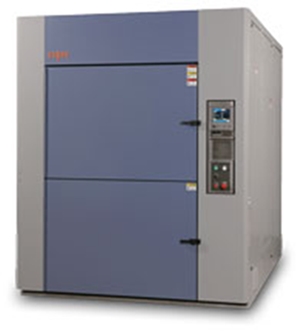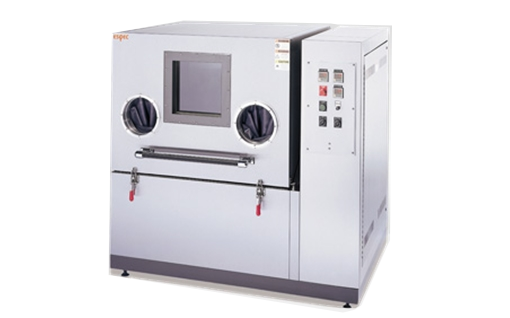Special tests: Rain, Dust, & Altitude
Temperature and humidity are not the only environmental conditions that products need to be tested to. ESPEC has developed specialized designs to allow testing for additional conditions that may affect products. Many of these originate from the automotive industry, which has to deal with the broadest range of operating conditions. Here are three unique systems:
Dust Chamber
Sounds simple enough—build a box that creates a continuous environment of dust. It is, but many other finer details are considered in Espec cabinets. The floor of the chamber is an inverse pyramid. At the tip of the cone, an air nozzle lets in compressed air. The cone is filled with dust (specifically, “Arizona fine dust”). A wire shelf above the floor holds the part under test. A window and rubber gloves through the door allow the parts to be turned to ensure even exposure without opening the door. Special considerations were made to ensure that the dust is continuously dispersed and not accumulating on the floor. The compressed air is dried to keep the dust from clumping. And a special clamshell type door is used for easy loading.
Dew Cycle Chamber
Most humidity tests are designed to avoid the creation of condensation, which has a completely different failure-mode than humidity. But, for some products, condensation is a very real consideration. By modifying a standard thermal shock chamber, condensation (or dew) can be created. The hot zone of the chamber has a humidifier added. As the product moves from the cold chamber to the hot and humid chamber, dew forms on it. Like taking a drink out of a refrigerator on a hot, humid day, the cold test sample attracts and condenses moisture from the air around it. The longer the condensation can stay on the product, the more effective the test usually is.

Altitude Chamber
The military was the first to need altitude chambers to simulate operation of critical equipment for planes and missiles. Today, there is a growing interest in altitude testing for land-based applications. High-powered communications equipment is dependent on air-cooling to remove the heat they generate. If installed at high altitude locations, the thinner air is not as effective for cooling, risking failures due to overheating. The challenge is to build a chamber-wall that will not collapse as the vacuum in the chamber pulls on it. Heavy gauge construction is the order, all around. The greater challenge for the system is to be able to cool this thinner air effectively while at the same time the test load is heating it.
VideoTesting for innovative storage solutions
Support when you need it
from expert people
Our after sales service and ability to support existing installations, from planned maintenance schedules and emergency repairs to full on-site refurbishment mean our customers equipment retains optimal performance and up time.


